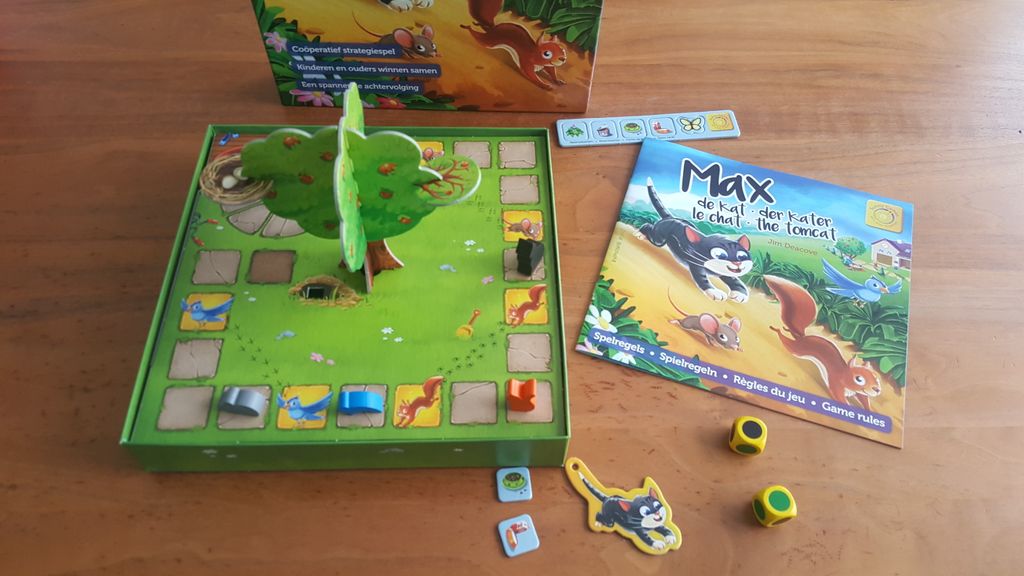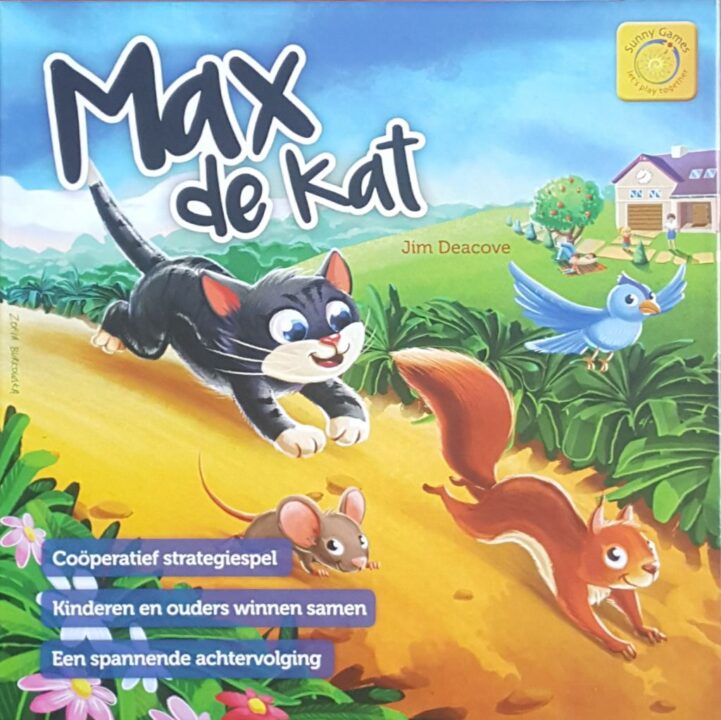Hey folks! Ready for another fun-filled board game review? Today, we’re talking about Max, a game that mixes charming artwork, social interaction, and strategy. Despite its delightful components, we’ll explore whether it holds up in terms of gameplay mechanics, balance, and replayability. Buckle up and get ready to find out if Max is worth adding to your collection!
How It Plays
Setting Up
First, set up the board and place Max the cat at the start. Put the birds, mouse, and squirrel at their start spots too. Give each player a pawn and the dice.
Gameplay
On your turn, roll the dice to move Max and the critters. Each die has special icons that decide if you move Max or a critter. Cooperate with other players to save the critters from Max’s clutches. Discuss, strategize, and sometimes argue (in a fun way) about the best moves.
Winning the Game
If all the critters make it home safely before Max catches them, everyone wins! But if Max catches any critter, it’s game over for everyone. Talk about feline ferocity!
Want to know more? Read our extensive strategy guide for Max.
Gameplay Mechanics and Balance in ‘Max’
Let’s jump right into the heart of any board game: the gameplay mechanics and balance. ‘Max’ brought me quite a few surprises. First off, the game features a cooperative mechanic, which means everyone wins or loses together. This can be great for family nights as it promotes teamwork over competition.
Each player takes on the role of one of Max’s friends – a crew of adorable animals. The objective is to get Max and his friends safely back to the treehouse. Sounds simple, right? Well, the game tosses in a couple of hurdles, like predatory animals. This adds some spice and keeps things interesting.
However, Max has a slight hiccup in its balance. The game leans more towards luck than skill. Dice rolls decide movements, and sometimes it feels like no matter what strategy you employ, the outcome is up to the unpredictable dice gods. It’s a bit of a bummer when you’ve meticulously planned your moves and a bad roll sends everything crashing down.
Despite this, the game has a nice pace. It doesn’t drag on, and you can fit in multiple rounds in one evening. This quick playtime helps mitigate the luck factor, since you can always give it another go. But if you’re someone who gets salty over bad rolls, you might find yourself storming off to the snacks table more than once.
Don’t get me wrong, ‘Max’ is endearing and great for casual fun. Just don’t expect it to be a strategic powerhouse. It’s more about the journey than the destination.
Next, I’ll delve into the player interaction and engagement, where things get even more fascinating.

Player Interaction and Engagement in ‘Max’
Let’s chat about ‘Max’ and its player interaction. This game will keep you chatting, plotting, and occasionally laughing until you can’t feel your cheeks anymore. I remember one session where my friend Sarah tricked us all into believing she was about to lose, only to swoop in for a surprise win. Classic Sarah move!
The beauty of ‘Max’ lies in its simplicity. The game’s mechanics encourage players to engage with each other. Whether you’re strategizing or negotiating with your opponents, the game forces you to stay connected. You’ll have moments where you need to convince others to support your plan, adding a layer of social interaction that’s often missing from more complex games.
One memorable round, I tried to convince my buddy Tom to trade resources with me. We spent more time laughing at my failed attempts than actually playing. It reminded me that ‘Max’ is more than just a game; it’s an experience. The interaction makes the game special and unique each time you play.
However, a small downside is that if you have a shy or introverted player, they might not engage as much as others. The game does require a bit of personality to shine through. But hey, that just means you get to see your friends’ true colors! Just make sure everyone is in the mood for a social game, or it could fall flat.
Are you ready to hear about the components and artwork quality of ‘Max’? Spoiler: It’s a visual treat!

Components and Artwork Quality of ‘Max’
When I first opened ‘Max,’ I felt like a kid on Christmas morning. The components are nothing short of delightful. The game pieces are sturdy and feel good in your hands. They’re not those flimsy bits that fly across the room if you sneeze too hard. Oh no, these are the real deal. You could probably use them as paperweights in a pinch, though I wouldn’t recommend it unless you want to turn your study sessions into an impromptu gaming marathon.
The board itself is a work of art. Seriously, I caught myself just staring at it for a while, daydreaming about a parallel universe where I could live in those vibrant landscapes. The artwork is colorful and detailed without feeling too busy. It strikes that sweet spot where you can appreciate the aesthetics but not get distracted from the game. Props to the artist for making my eyeballs so happy!
As for the cards, they are excellent quality. You won’t need to sleeve them unless you’re the kind of person who sleeves everything, including their morning toast. The illustrations are as charming as the board, with little touches that show a lot of love went into the design. Seeing those characters and locations just adds another layer of immersion to the game.
To summarize, the components and artwork of ‘Max’ are top-notch. They add to the joy of the game and make me want to keep coming back for more, even if the gameplay isn’t always perfect. Next, let’s get into Replayability and value for money, because hey, who doesn’t want their board games to feel like a great investment?
Replayability and Value for Money in ‘Max’
Alright folks, let’s talk about the big cheese: replayability and value for money. Because, let’s face it, nobody wants a board game that collects dust after one play.
With ‘Max,’ replayability is a bit of a mixed bag. The game offers a decent amount of variety thanks to its ever-changing board and the different strategies you can employ. However, after a few rounds, you might start to notice patterns. Once you figure out the optimal moves, the game can feel a bit ‘rinse and repeat.’
But fear not! ‘Max’ still manages to keep things fresh with its cute theme and engaging gameplay. The game is quick to set up and plays in about 30 minutes. So, it makes for a great filler game between more complex ones. Perfect for breaking the ice at game night or for a quick round before bed.
As for value for money, ‘Max’ doesn’t break the bank. It’s affordable, and the components are solid for the price you pay. The cute artwork and sturdy pieces add a nice touch, making the game feel more premium than its price tag suggests.
However, if you’re someone who craves deep, strategic gameplay with high replay value, ‘Max’ might not hit the mark. It leans more towards casual fun and is excellent for families and light-hearted gaming sessions. But for seasoned gamers, it might lack the depth you’re looking for.
In conclusion, if you’re after a light and fun game that’s easy on the wallet, ‘Max’ is worth a try. Just don’t expect it to be the centerpiece of your game night collection.
Conclusion
Wrapping this up, ‘Max’ is a charming little game that offers a lot of fun with its delightful components and engaging social interaction. The artwork is a visual treat, but beware, the game leans heavily on luck, which might not sit well with everyone. It’s affordable and great for casual gamers or family game nights, though it may not have the deep replayability some hardcore gamers crave. All in all, ‘Max’ is a wonderful pick for light-hearted gaming sessions, just don’t expect a perfectly balanced strategic masterpiece.

